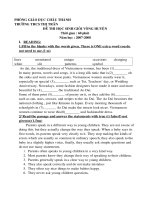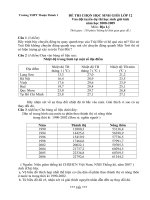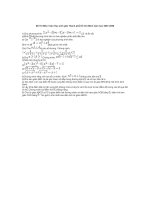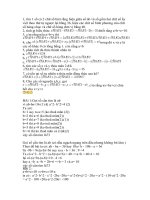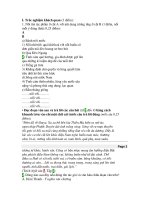Toán học sinh giỏi Bulgary 1960 - 2008
Bạn đang xem bản rút gọn của tài liệu. Xem và tải ngay bản đầy đủ của tài liệu tại đây (406.49 KB, 104 trang )
Bulgarian Mathematical Olympiad
1960 - 2008
(Only problems)
DongPhD
DongPhD Problem Books
Series
υo.3
Available at
1
DongPhD 2
Bulgarian Mathematical Olympiad 1960, III Round
First Day
1. Prove that the sum (and/or difference) of two irreducible frac-
tions with different divisors cannot be an integer number. (7
points)
2. Find minimum and the maximum of the function:
y =
x
2
+ x + 1
x
2
+ 2x + 1
if x can achieve all possible real values. (6 points)
3. Find tan of the angles: x, y, z from the equations: tan x : tan y :
tan z = a : b : c if it is known that x + y + z = 180
◦
and a, b, c
are positive numbers. (7 points)
Second day
4. There are given two externally tangent circles with radii R and
r.
(a) prove that the quadrilateral with sides - two external tan-
gents to and chords, connecting tangents of these tangents
is a trapezium;
(b) Find the bases and the height of the trapezium.
(6 points)
5. The rays a, b, c have common starting point and doesn’t lie in
the same plane. The angles α = ∠(b, c), β = ∠(c, a), γ = ∠(a, b),
are acute and their dimensions are given in the drawing plane.
Construct with a ruler and a compass the angle between the ray
a and the plane, passing through the rays b and c. (8 points)
DongPhD 3
6. In a cone is inscribed a sphere. Then it is inscribed another
sphere tangent to the first sphere and tangent to the cone (not
tangent to the base). Then it is inscribed third sphere tangent
to the second sphere and tangent to the cone (not tangent to the
base). Find the sum of the surfaces of all inscribed spheres if the
cone’s height is equal to h and the angle throught a vertex of the
cone formed by a intersection passing from the height is equal to
α. (6 points)
DongPhD 4
Bulgarian Mathematical Olympiad 1961, III Round
First Day
1. Let a and b are two numbers with greater common divisor equal
to 1. Prove that that from all prime numbers which square don’t
divide the number: a + b only the square of 3 can divide simul-
taneously the numbers (a + b)
2
and a
3
+ b
3
. (7
points)
2. What relation should be between p and q so that the equation
x
4
+ px
2
+ q = 0
have four real solutions forming an arithmetic progression? (6
points)
3. Express as a multiple the following expression:
A =
√
1 + sin x −
√
1 − sin x
if −
7π
2
≤ x ≤ −
5π
2
and the square roots are arithmetic. (7
points)
Second day
4. In a circle k are drawn the diameter CD and from the same half
line of CD are chosen two points A and B. Construct a point
S on the circle from the other half plane of CD such that the
segment on CD, defined from the intersecting point M and N
on lines SA and SB with CD to have a length a. (7 points)
5. In a given sphere with radii R are situated (inscribed) six same
spheres in such a way that each sphere is tangent to the given
sphere and to four of the inscribed spheres. Find the radii of
inscribed spheres. (7 points)
DongPhD 5
6. Through the point H, not lying in the base of a given regular
pyramid is drawn a perpendicular to the plane of the base. Prove
that the sum from the segments from H to intersecting points of
the perpendicular given to the planes of all non-base sides of the
pyramid doesn’t depend on the position of H on the base plane.
(6 points)
DongPhD 6
Bulgarian Mathematical Olympiad 1962, III Round
First Day
1. It is given the sequence: 1, 1, 2, 3, 5, 8, 13, . . . , each therm of
which after the second is equal to the sum of two terms before
it. Prove that the absolute value of the difference between the
square of each term from the sequence and multiple of the term
before it and the term after it is equal to 1. (7 points)
2. Find the solutions of the inequality:
x
2
− 3x + 2 > x − 4
(7 points)
3. For which triangles the following equality is true:
cos
2
α cot β = cot α cos
2
β
(6 points)
Second day
4. It is given the angle ∠XOY = 120
◦
with angle bisector OT .
From the random point M chosen in the angle ∠T OY are drawn
perpendiculars MC, MA and MB respectively to OX, OY and
OT . Prove that:
(a) triangle ABC is equilateral;
(b) the following relation is true: MC = MA + MB;
(c) the surface of the triangle ABC is S =
√
3
4
a
2
+ ab + b
2
,
where MA = a, MB = b.
(7 points)
5. On the base of isosceles triangle ABC is chose a random point
M. Through M are drawn lines parallel to the non-base sides,
intersecting AC and BC respectively at the points D and E:
DongPhD 7
(a) prove that: CM
2
= AC
2
− AM · BM;
(b) find the locus of the feets to perpendiculars drawn from the
centre of the circumcircle over the triangle ABC to diago-
nals MC and ED of the parallelogram MECD when M is
moving over the base AB;
(c) prove that : CM
2
= AC
2
− AM · BM if M is over the
extension of the base AB of the triangle ABC.
(7 points)
6. What is the distance from the centre of a sphere with radii R
for which a plane must be drawn in such a way that the full
surface of the pyramid with vertex same as the centre of the
sphere and base square which is inscribed in the circle formed
from intersection of the sphere and the plane is 4 m
2
.
(6 points)
Bulgarian Mathematical Olympiad 1962, IV Round
1. It is given the expression y =
x
2
−2x+1
x
2
−2x+2
, where x is a variable.
Prove that:
(a) if x
1
and x
2
are two random values of x, and y
1
and y
2
are
the respective values of y if ≤ x
1
< x
2
, y
1
< y
2
;
(b) when x is varying y attains all possible values for which:
0 ≤ y < 1
(5 points)
2. It is given a circle with center O and radii r. AB and MN
are two random diameters. The lines MB and NB intersects
tangent to the circle at the point A respectively at the points M
and N
. M
and N
are the middlepoints of the segments AM
and AN
. Prove that:
(a) around the quadrilateral MNN
M
may be circumscribed
a circle;
DongPhD 8
(b) the heights of the triangle M
N
B intersects in the middle-
point of the radii OA.
(5 points)
3. It is given a cube with sidelength a. Find the surface of the
intersection of the cube with a plane, perpendicular to one of its
diagonals and which distance from the centre of the cube is equal
to h. (4 points)
4. There are given a triangle and some its internal point P. x, y,
z are distances from P to the vertices A, B and C. p, q, r are
distances from P to the sides BC, CA, AB respectively. Prove
that:
xyz = (q + r)(r + p)(p + q)
(6 points)
DongPhD 9
Bulgarian Mathematical Olympiad 1963, III Round
First Day
1. From the three different digits x, y, z are constructed all possible
three-digit numbers. The sum of these numbers is 3 times bigger
than the number which all three digits are equal to x. Find the
numbers: x, y, z.
(7 points)
2. Solve the inequality:
1
2(x − 1)
−
4
x
+
15
2(x + 1)
≥ 1
(7 points)
3. If α, β, γ are the angles of some triangle prove the equality:
cos
2
α + cos
2
β + cos
2
γ + 2 cos α cos β + cos γ = 1
(6 points)
Second day
4. Construct a triangle, similar to a given triangle one if one of its
vertices is same as a point given in advance and the other two
vertices lie at a given in advance circle. (Hint: You may use
circumscribed around required triangle circle) (8 points)
5. A regular tetrahedron is cut from a plane parallel to some of
its base edges and to some of the other non-base edges, non
intersecting the given base line. Prove that:
(a) the intersection is a rectangle;
(b) perimeter ot the intersection doesn’t depent of the situation
of the cutting plane.
(5 points)
DongPhD 10
6. Find dihedral line ϕ, between base wall and non-base wall of
regular pyramid which base is quadrilateral if it is known that
the radii of the circumscribed sphere bigger than the radii of the
inscribed sphere.
(7 points)
Bulgarian Mathematical Olympiad 1963, IV Round
1. Find all three-digit numbers which remainders after division by
11 give quotient, equal to the sum of it’s digits squares. (4
points)
2. It is given the equation x
2
+ px + 1 = 0, with roots x
1
and x
2
;
(a) find a second-degree equation with roots y
1
, y
2
satisfying
the conditions: y
1
= x
1
(1 − x
1
), y
2
= x
2
(1 − x
2
);
(b) find all possible values of the real parameter p such that the
roots of the new equation lies between -2 and 1.
(5 points)
3. In the trapezium ABCD with on the non-base segment AB is
chosen a random point M. Through the points M, A, D and M,
B, C are drawn circles k
1
and k
2
with centers O
1
and O
2
. Prove
that:
(a) the second intersection point N of k
1
and k
2
lies on the
other non-base segment CD or on its continuation;
(b) the length of the line O
1
O
2
doesn’t depend of the situation
on M over AB;
(c) the triangles O
1
MO
2
and DMC are similar. Find such a
position of M over AB that makes k
1
and k
2
with the same
radii.
(6 points)
4. In the tetrahedron ABCD three of the sides are right-angled
triangles and the second in not an obtuse triangle. Prove that:
DongPhD 11
(a) the fourth wall of the tetrahedron is right-angled triangle if
and only if exactly two of the plane angles having common
vertex with the some of vertices of the tetrahedron are equal.
(b) when all four walls of the tetrahedron are right-angled tri-
angles its volume is equal to
1
6
multiplied by the multiple of
three shortest edges not lying on the same wall.
(5 points)
Remark for (b) - more correct statement should be: ··· its
volume is equal to
1
6
multiplied by the multiple of two shortest
edges and an edge not lying on the same wall.
DongPhD 12
Bulgarian Mathematical Olympiad 1964, III Round
First Day
1. Find four-digit number: xyzt which is an exact cube of natural
number if its four digits are different and satisfy the equations:
2x = y − z and y = t
2
. (7 points)
2. Find all possible real values of k for which roots of the equation
(k + 1)x
2
− 3kx + 4k = 0
are real and each of them is greater than -1. (7 points)
3. Find all real solutions of the equation:
x
2
+ 2x cos(xy) + 1 = 0
(7 points)
Second day
4. A circle k and a line t are tangent at the point T . Let M is a
random point from t and MA is the second tangent to k. There
are drawn a diameter AB and a perpendicular T C to AB (C lies
on AB):
(a) prove that the intersecting point P of the lines MB and T C
is a midpoint of the segment TC;
(b) find the locus of P when M is moving over the line t.
(7 points)
5. In the tetrahedron ABCD all pair of opposite edges are equal.
Prove that the lines passing through their midpoints are mutually
perpendicular and are axis of symmetry of the given tetrahedron.
(7 points)
DongPhD 13
6. Construct a right-angled triangle by given hypotenuse c and an
obtuse angle ϕ between two medians to the cathets. Find the
allowed range in which the angle ϕ belongs (min and max possible
value of ϕ).
Bulgarian Mathematical Olympiad 1964, IV Round
1. A 6n-digit number is divisible by 7. Prove that if its last digit is
moved at the beginning of the number (first position) then the
new number is also divisible by 7. (5 points)
2. Find all possible n-tuples of reals: x
1
, x
2
, . . . , x
n
satisfying the
system:
x
1
· x
2
···x
n
= 1
x
1
− x
2
· x
3
···x
n
= 1
x
1
· x
2
− x
3
· x
4
···x
n
= 1
···
x
1
· x
2
···x
n−1
− x
n
= 1
(4 points)
3. There are given two intersecting lines g
1
, g
2
and a point P in
their plane such that ∠(g
1
, g
2
) = 90
◦
. Its symmetrical points on
any random point M in the same plane with respect to the given
planes are M
1
and M
2
. Prove that:
(a) the locus of the point M for which the point M
1
, M
2
and P
lies on a common line is a circle k passing intersecting point
of g
1
and g
2
.
(b) the point P an orthocenter of the triangle, inscribed in the
circle k sides of which lies at the lines g
1
and g
2
.
(6 points)
4. Let a
1
, b
1
, c
1
are three lines each two of them are mutually crossed
and aren’t parallel to some plane. The lines a
2
, b
2
, c
2
intersects
DongPhD 14
the lines a
1
, b
1
, c
1
at the points a
2
in A, C
2
, B
1
; b
2
in C
1
, B, A
2
;
c
2
in B
2
, A
1
, C respectively in such a way that A is the middle
line of B
1
C
2
, B is the middle of C
1
A
2
and C is the middle of
A
1
B
2
. Prove that:
(a) A is the middle of the B
2
C
1
, B is the middle of C
2
A
1
and
C is the middle of A
2
B
1
;
(b) triangles A
1
B
1
C
1
and A
2
B
2
C
2
are the same. (A
1
B
1
C
1
A
2
B
2
C
2
- is a prism).
(5 points)
DongPhD 15
Bulgarian Mathematical Olympiad 1965, III Round
First Day
1. On a circumference are written 1965 digits, It is known if we read
the digits on the same direction as the clock hand is moving,
resulting 1965-digit number will be divisible to 27. Prove that
if we start reading of the digits from some other position the
resulting 1965-digit number will be also divisible to 27. (7
points)
2. Find all real roots of the equation:
x
2
− 2p +
4x
2
− p − 2 = x
where p is real parameter. (points)
3. Prove that if α, β, γ are angles of some triangle then
A = cos α + cos β + cos γ < 2
(6 points)
Second day
4. It is given an acute-angled triangle ABC. Perpendiculars to AC
and BC drawn from the points A and B intersects in the point
P . Q is the projection of P on AB. Prove that the arms of
∠ACB cut from a line passing through Q and different from AB
segment bigger than the segment AB. (7 Points)
5. Construct a triangle ABC by given side AB = c and distances
p and q from vertices A and B to the angle bisector of angle C.
Express the area of the triangle ABC by c, p and q. (7 points)
6. Let P is not an external point to the tetrahedron DABC differ-
ent from the point D. Prove that from the segments P A, P B,
P C can be chosen a segment that is shorter from some of the
segments DA, DB, DC.
(6 points)
DongPhD 16
Bulgarian Mathematical Olympiad 1965, IV Round
1. The numbers 2, 3, 7 have the property that the multiple of any
two of them increased by 1 is divisible of the third number. Prove
that this triple of integer numbers greater than 1 is the only triple
with the given property. (6 points)
2. Prove the inequality:
1 + sin
2
α
n
+
1 + cos
2
α
n
2
3
2
n
is true for every natural number n. When does equality holds?
(5 points)
3. In the triangle ABC angle bisector CD intersects circumscribed
around ABC circle at the point K.
(a) Prove the equalities:
1
JD
−
1
JK
=
1
CJ
,
CJ
JD
−
JD
DK
= 1
where J is the centre of the inscribed circle.
(b) On the segment CK is chosen a random point P with pro-
jections on AC, BC, AB respectively: P
1
, P
2
, P
3
. The lines
P P
3
and P
1
P
2
intersects at a point M. Find the locus of M
when P is moving around the CK segment.
(9 points)
4. In the space are given crossed lines s and t such that ∠(s, t) = 60
◦
and a segment AB perpendicular to them. On AB is chosen a
point C for which AC : CB = 2 : 1 and the points M and N
are moving on the lines s and t in such a way that AM = 2BN.
Prove that
1
:
(a) the segment MN is perpendicular to t;
1
In the statement should be said that vectors
−−→
AM and
−−→
BM have the angle between them 60
◦
DongPhD 17
(b) the plane α, perpendicular to AB in point C intersects the
plane CMN on fixed line with given direction in respect
to s and t;
(c) reverse, all planes passing by ell and perpendicular to AB
intersects the lines s and t respectively at points M and N
for which AM = 2BN and MN⊥t.
(6 points)
DongPhD 18
Bulgarian Mathematical Olympiad 1966, III Round
First Day
1. Find all possible values of the natural number n for which the
number n
n+1
− (n + 1)
n
is divisible by 3. (6 Points)
2. Prove the inequality:
log
b+c
a
2
+ log
c+a
b
2
+ log
a+b
c
2
≥ 3
where the numbers a, b, c are not smaller than 2. (8 points)
3. In the plane are given n points. It is known that if we choose any
four of these points there are three points that lie on a common
straight line. Prove that all n points maybe except one lie on a
common straight line.
(6 points)
Second day
4. It is given a tetrahedron ABCD. Medians of the triangle BCD
meets each other in point M. Prove the inequality:
AM ≤
AB + AC + AD
3
(5 Points)
5. In the triangle ABC the angle bisector, median and the height
drawn respectively through the vertices A, B, C intersects at
a common point. Prove that the angles A, B, C satisfies the
equation:
tan A =
sin B
cos C
(9 Points)
DongPhD 19
6. In a tourist tour participates yang people, girls and boys. It
is known that every boy knows at least one girl but he doesn’t
know all the girls, and every girl knows at least one of the boys
but she doesn’t know all the boys. Prove that from participants
may be chosen two boys and two girls such that each of the
selected boys knows one of the selected girls but doesn’t know
the other selected girl and each of the selected girls knows one
of the selected boys but doesn’t know the other selected boy. (6
Points)
Bulgarian Mathematical Olympiad 1966, IV Round
1. Prove that the equality:
3x(x − 3y) = y
2
+ z
2
doesn’t have other integer solutions except x = 0, y = 0, z = 0.
(5 points)
2. Prove that for every four positive numbers a, b, c, d is true the
following inequality:
a
2
+ b
2
+ c
2
+ d
2
4
3
abc + abd + acd + bcd
4
(7 points)
3. (a) In the plane of the triangle ABC find a point with the
following property: its symmetrical points with respect to
middle points of the sides of the triangle lies on the circum-
scribed circle.
(b) Construct the triangle ABC if it is known the positions of
the orthocenter H, middle point of the side AB and the
middle point of the segment joining the foots of the heights
through vertices A and B.
(9 points)
4. It is given a tetrahedron with vertices A, B,
DongPhD 20
(a) Prove that there exists vertex of tetrahedron with the fol-
lowing property: the three edges of that tetrahedron can be
constructed a triangle.
(b) Over the edges DA, DB and DC are given the points M,
N and P for which:
DM =
DA
n
, DN =
DB
n + 1
, DP =
DC
n + 2
where n is a natural number. The plane defined by the
points M, N and P is α
n
. Prove that all planes α
n
, (n =
1, 2, 3, . . . ) passes through a single straight line.
(9 points)
DongPhD 21
Bulgarian Mathematical Olympiad 1967, III Round
First Day
1. Find four digit number which on division by 139 gives a remain-
der 21 and on division by 140 gives a remainder 7. (7
Points)
2. There are given 12 numbers a
1
, a
2
, . . . , a
12
satisfying the condi-
tions:
a
2
(a
1
− a
2
+ a
3
) < 0
a
3
(a
2
− a
3
+ a
4
) < 0
···
a
11
(a
10
− a
11
+ a
12
) < 0
Prove that among these numbers there are at least three positive
and three negative. (6 points)
3. On time of suspension of arms around round (circular) table are
situated few knights from two enemy’s camps. It is known that
the count of knights with an enemy on its right side is equal to
the count of knights with a friend on its right side. Prove that
the total count of the knights situated around the circular table
is divisible by 4. (7 points)
Second day
4. In the triangle ABC from the foot of the altitude CD is drawn a
perpendicular DE to the side BC. On the line DC is taken point
H for which DH : HE = DB : DA. Prove that the segments
CH and AE are mutually perpendicular. (6 Points)
5. Prove that for each acute angled triangle is true the following
inequality:
m
a
+ m
b
+ m
c
≤ 4R + r
(8 Points)
DongPhD 22
6. From the tetrahedrons ABCD with a given volume V for which:
AC⊥CD⊥DB⊥AC
find this one with the smallest radii of the circumscribed sphere.
(6 Points)
Bulgarian Mathematical Olympiad 1967, IV Round
1. The numbers 12, 14, 37, 65 are one of the solutions of the equa-
tion:
xy − xz + yt = 182
What number of what letter corresponds? (5 points)
2. Prove that:
(a) if y <
1
2
and n ≥ 3 is a natural number then: (y + 1)
n
≥
y
n
+ (1 + 2y)
n
2
;
(b) if x, y, z and n ≥ 3 are natural numbers for which: x
2
−1 ≤
2y then x
n
+ y
n
= z
n
.
(9 points)
3. It is given a right-angled triangle ABC and its circumcircle k.
(a) prove that the radii of the circle k
1
tangent to the cathets
of the triangle and to the circle k is equal to the diameter
of the incircle of the triangle ABC.
(b) on the circle k may be found a point M for which the sum
MA + MB + MC is biggest possible.
(11 points)
4. Outside of the plane of the triangle ABC is given point D.
(a) prove that if the segment DA is perpendicular to the plane
ABC then orthogonal projection of the orthocenter of the
triangle ABC on the plane BCD coincides with the ortho-
center of the triangle BCD.
DongPhD 23
(b) for all tetrahedrons ABCD with base, the triangle ABC
with smallest of the four heights that from the vertex D,
find the locus of the foot of that height.
(10 points)
DongPhD 24
Bulgarian Mathematical Olympiad 1968, III Round
First Day
1. Find four digit number 1xyz, if two of the numbers xz, yx + 1,
zy −2 are divisible by 7 and x + 2y + z = 29. (6 Points)
2. Find the numbers A, B, C in such a way that for every natural
number n is true the following equality
1
2
+
2
2
2
+
3
2
3
+ ···+
n
2
n
=
An + B
2
n
+ C
(7 Points)
3. Solve the inequality
(1 − cos x)(1 + cos 2x)(1 − cos 3x) <
1
2
(7 Points)
Second day
4. The points A, B, C and D are sequential vertices of regular
polygon and the following equality is satisfied
1
AB
=
1
AC
+
1
AD
How much sides the polygon have ? (6 Points)
5. In a triangle ABC over the median CM is chosen a random point
O. The lines AO and BO intersects the sides BC and AC at
the points K and L respectively. Prove that if AC > BC then
AK > BL. (6 Points)
6. The base of pyramid SABCD (with base ABCD) is a quadri-
lateral with mutually perpendicular diagonals. The orthogonal
projection of the vertex S over the base of the pyramid coincides
with the intersection point of the diagonals AC and BD. Prove
that the orthogonal projections of the point O over the walls of
the pyramid lies over a common circle. (8 Points)
DongPhD 25
Bulgarian Mathematical Olympiad 1968, IV Round
First Day
1. Find all possible natural values of k for which the system
x
1
+ x
2
+ ···+ x
k
= 9
1
x
1
+
1
x
2
+ ···+
1
x
k
= 1
have solutions in positive numbers. Find these solutions.
(6 points, I. Dimovski)
2. Find all functions f(x), defined for every x, y satisfying the equal-
ity
xf(y) + yf(x) = (x + y)f(x)f(y)
for every x, y. Prove that exactly two of them are continuous.
(6 points, I. Dimovski)
3. Prove that a binomial coefficient
n
k
is odd if and only if all digits
1 of k, when k is written in binary digit system are on the same
positions when n is written in binary system. (8 points, I.
Dimovski)
Second day
4. Over the line g are given the segment AB and a point C external
for AB. Prove that over g there exists at least one pair of points
P , Q symmetricalwith respect to C, which divide the segment
AB internally and externally in the same ratios, i.e.
P A
P B
=
QA
QB
(1)
Opposite if A, B, P , Q are such points from the line g for which
is satisfyied (1), prove that the middle point C of the segment
P Q is external point for the segment AB. (6 points, K. Petrov)
